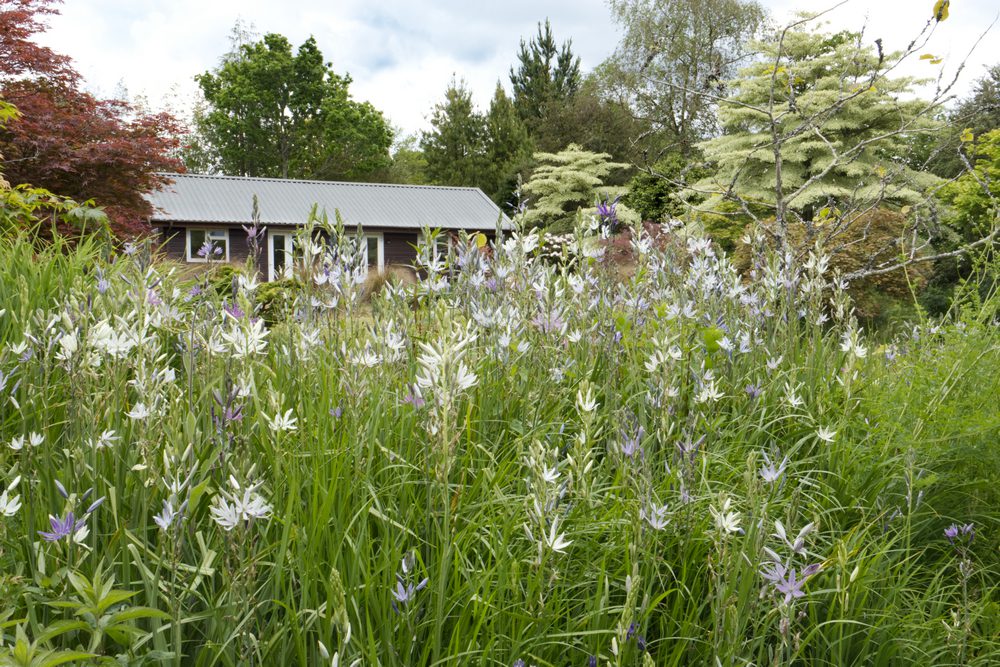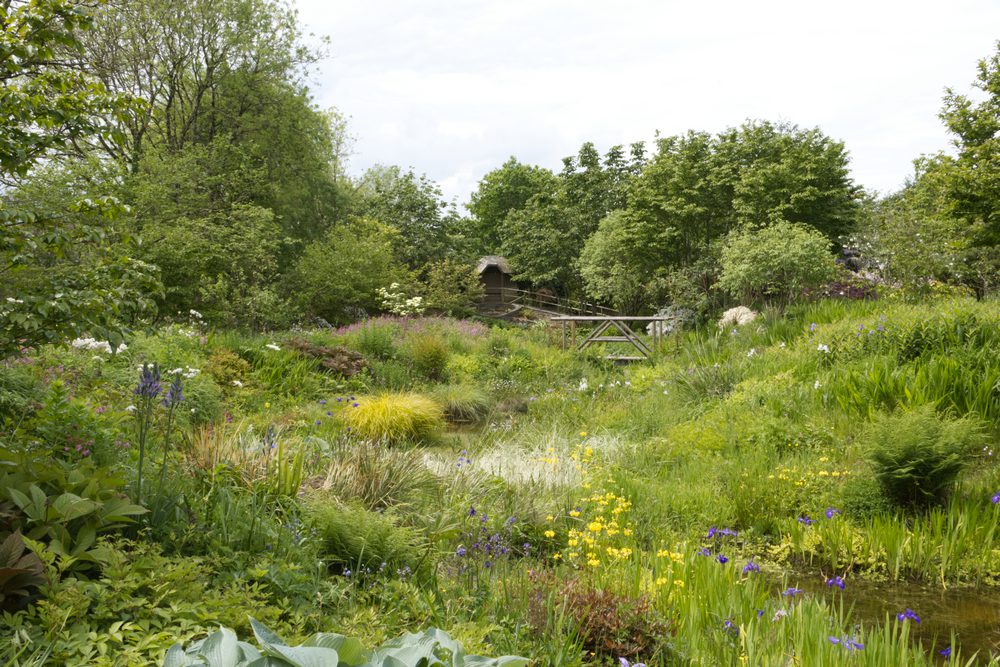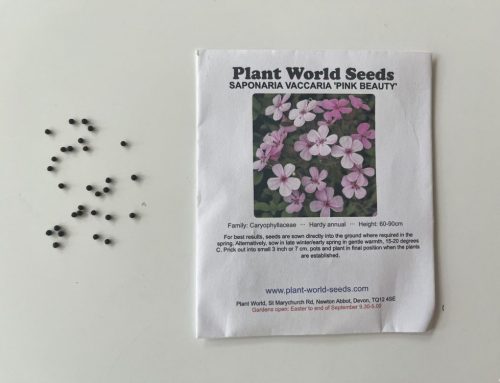I’d planned a leisurely morning. A bit of gentle pottering around in my own garden, then out later to deal with something at a garden I look after.
My phone buzzed: fellow Ranter Marianne was in my area, should we meet up?
Wildside
We visited Wildside, a small but interesting garden near the romantically named Devon village of Buckland Monachorum.
Created by Keith Wiley and his late wife Ros, Wildside describes itself as an experimental garden. There are no lab coats and carefully controlled conditions here: this is an experiment in New Naturalism.

A scene in the central part of Wildside, the only flat part of the garden
When Wildside was conceived, just 20 years ago, New Naturalism was still very much in its infancy in the UK. The British gardening scene at the time was dominated by the ‘garden makeover’, largely thanks to a popular TV show called ‘Ground Force’. The premise was that a team of gardening presenters created a new garden to surprise someone who had experienced a tragedy or difficult time in their life. Looking back it was rather formulaic; a Japanese maple (Acer palmatum), a bamboo, a water feature, a deck and so on. No doubt it was easier to adapt a set formula to each garden rather than to design from the beginning each time; it certainly did wonders for sales of maples, bamboos, water features and decking at the time
The New Naturalism pioneered by the late Henk Gerritsen, and popularised and further developed by Piet Oudolf and others, was a strange new idea.
What Makes Wildside Different?
Generally speaking, designers create gardens that largely work with the natural topography of the site. Usually there is a reluctance to do too much groundwork beforehand, work which adds to costs and slows progress.
By contrast the gently sloping site at Wildside was restructured to build a series of mounds and valleys; the topography of Wildside is nearly all completely artificial.

This hill hasn’t always been there
Why go to such lengths to create a garden when it’s much easier to create a garden on a gentler site?
Gardening with dramatic slopes can indeed be a challenge, but can also offer different opportunities. Get the planting right on sloping ground and you can display plants in a more ‘three-dimensional’ way.

It’s easy to enjoy the beauty of camassias at eye level
Think in terms of a school photograph: if everyone is standing at the same level then it’s difficult to make sure that everyone is in the picture, but if you stand students on tiered staging you can show everyone equally, making a much better group photograph.
What Use Is This To Us?
The two main areas of interest at Wildside are the physical structure of the garden and the planting.
In addition to showing the plants off to their best advantage, the artificial hills at Wildside create a series of habitats for plants; on one side of a hill it will be hot and sunny, creating the perfect place for plants that prefer these conditions, while on the other side it will be cooler and shadier. An interesting selection of trees also helps to cast shade too.

Luxuriant shade loving plants
Usually gardeners rely on trees, shrubs and hedges to create different growing conditions. This is perfectly reasonable, practical, and a less expensive and destructive way to make a garden. Wildside demonstrates an alternative approach, changing the ground itself to create different areas of the garden.
The planting is broadly speaking separated into zones according to the plant’s needs, the classic ‘right plant, right place’ mantra at work. However while there are clearly themes to the planting there isn’t a rigorous attempt to by puritanical about them. If a plant looks right and will grow well then it is included in that part of the garden. The idea is to nurture a sense of place rather than to show off a botanical collection.

The plants at Wildside seem to get along
Marianne and I both saw plants that are unfamiliar to us and we would love to have known what they were, but at the same time the overall effect was so captivating that we didn’t really mind too much.

White irises and thalictrums punctuate shades of green, yellow and blue
We were quite taken with a white Siberian iris (Iris sibirica) next to a pond; we gardeners usually prefer the effect of massed flowers in our gardens. Irises however have a distinctive shape, an architecture to the flowers, that can get lost when they’re all close together. We noticed how much more impact the small dabs of white had than a big clump, and how even at a distance you could make out the distinctive shape of the iris flowers.
In Conclusion
Don’t hire machinery to rip up your garden just yet.
Creating Wildside has been a labour of love for a long time; it’s been a massive undertaking and labour of love, and took nearly 20 years for the whole garden to come together. The apocalyptic earthworks of the early days, the subject of much local discussion, have been vindicated by the garden as it stands today.

Trees are maturing nicely, but so is the underplanting
The landforms at Wildside are beyond most of us to replicate but remain interesting; when construction work is carried out there is often a lot of soil that must be removed. It might be possible to reuse this soil in the garden, to create interesting changes of level in the garden rather than paying for the soil to be taken away. If your garden has very poor soil then you might consider bringing soil in and creating landforms on top of the underlying soil, giving you good growing conditions without having to spend endless time and money trying to improve your existing soil.
Also, and it’s a point that needs to be stressed far more in gardening, have fun. Be as brave and as bold as you can.
Mix things up.
Defy convention. Push the boundaries and don’t be afraid to question conventional gardening wisdom and practice.

Bearded irises seem happy in the sunnier parts of the garden
Gardening has become beholden to the words of a small group of people/organisations perceived to be all-knowing, but this hasn’t always been the case. Before we had endless books and websites telling us what to do and how to do it, gardeners were free to experiment with ideas and share their results with other gardeners. Older gardening magazines contained letters and articles from ordinary gardeners keen to share information based on their observations.
Most things in gardening came about because someone had an idea and tried it out. There’s increasingly a sense that gardening has become stagnant, with progress inhibited because gardeners believe that the practices taught on horticulture courses and in books represent the pinnacle of our understanding rather than just suggestions about how things can be done.
20 years ago gardeners believed Keith Wiley was mad to dig up his gently sloping field; they now flock to Wildside to see the results of his efforts. Hopefully others will be inspired to make their own Wildside.
A few might even be inspired to improve on Keith Wiley’s work, after all New Naturalism was built on the foundations laid down by William Robinson over a century before.





love your advice –mix things up and push the boundaries. there is nothing more boring than traditional trade plants each separated by mulch in predictable patterns. The English cottage garden look is so appealing, but of course it’s all carefully planned and maintained to appear spontaneous and wild. Gardening is in fact manipulating the environment for human pleasure and need.
I cannot understand the obsession some gardeners have with islands of plants in seas of mulch. I just don’t see the appeal.
All gardens require a degree of intervention or, if you will, manipulation. A little nudge to keep things going in the right direction. Even native planting enthusiasts come to learn that a garden is not a genteel fairyland; plants, all plants, are involved in a fight to the death, and sometimes you need to get in there and curtail the more dominant species to protect the weaker.
You and I would call this process ‘gardening’.
Thank you for another lovely and thoughtful post, Ben. A former neighbor asked me to come around to her “new” home (actually an old house she’s renovating) and have a look at its garden, which has been a bit neglected. She had been in our garden, admired it, and was looking for some tips and advice about where to start. I was happy to pay her a visit and while doing so, could sense how overwhelmed she was with the task of creating a garden while caring for her two young children, working on her home, her husband often off traveling etc. She seemed so dreadfully scared to do something wrong. As if there were a “right” and “wrong” way. You are so right when you say that gardening should be fun. There must be joy in it and the willingness to take a chance. And the goal should be to bring joy to yourself. If others like it, well lovely for them. But it’s your sweat and tears and mosquito bites and dirty fingernails and vision and staring and thinking and wondering and sore back that make a garden. And it should make YOU happy. I did lend my old neighbor some of my favorite gardening books, with inspiring photographs, but was sure to emphasize that the garden is hers and that she needs to trust herself. She doesn’t need to please anyone else with it.
Jill, I second your comment. I also firmly believe a garden should please its creator(s) first and foremost. If others like it, that delights me, too.
Absolutely.
This is exactly the thing; it’s your friend’s garden, and she must be the person who enjoys it the most.
There’s no time limit on how quickly things must be done, and there are so many different ways a garden can be styled. It should be about enjoying the garden and trying out new ideas, not some earnest attempt to please an audience.
When I get back to my garden I will plant only native plants. The far rear will be a meadow with a path if needed, and I will love the change.
A neatly mown path through a luxuriance of wild plants is a very powerful design motif.
Lovely photos, and such an unusual topic.
I love hills/mounds in gardening myself, and have been attempting to do a backyard-sized version at my home. Year One, I just mounded up a year’s worth of yard waste and topped with soil and compost. They’re very modest, but growing things well enough so far. I’ve noticed it slides more than I’d like and can be tricky to water as a result. Year Two, I want to fix this by making them bigger across and with a less aggressive slope, and might even cover the sides with burlap to reduce erosion while groundcover plants do their job to solidify the mound. I have no idea what I’m doing, but it’s fun figuring it out!
Perhaps you’d do an article sometime about how to go about constructing mounds, both on a grand scale and on a smaller scale?
I could but it would be a difficult one to illustrate.
I suspect you might see a bit of slumping as your hills are made of looser organic matter, but as your plants establish things should calm down. Certainly a gentler slope will reduce erosion and groundcover plants will be a huge help too.
Exciting that you’re doing this, and I wish you every success.
Wildside brings to mind the Summer Palace in Beijing, 17 acres restored for the pleasure of the Empress Dowager Xici. Multiple lakes were excavated on mostly flat ground, the spoils used to create a lakeside mountain, upon which pleasure palaces and pavilions were constructed, some 3000 rooms in all. Should she tire of lazing on the stationary Stone Boat with working stone paddle wheels, there was always the option of an outing on an entourage of imperial barges, along a winding waterway to the entirely fabricated canal town of “Suzhou”, lined with dozens of fully staffed, fully stocked shops festooned with colorful flags. So, yeah, land forming can be fun.
Granted Wildside is on a much more modest scale…
Thanks Ben,
In regards to the Wildside Garden in Devon I am absolutely impressed by their major achievement of endless waves of plants complimenting each other in a harmony and balance so appealing to the human senses and replete with aesthetic beauty. I do however, feel a contradiction mounting in me when I imagine all the alterations made with what I assume involved heavy equipment and well thought out schematics needed to execute the design and placement of plant material, ponds and rock gardens. The suffix “wild” to me means unadulterated, what grows, grows, catch as catch can, left to its own accord. Thus being, is not usually pretty, balanced or appealing. This garden and the High Line Park in Manhattan, New York, designed primarily by Piet Oudolf (bless his heart) to me is the epitome of gardening as it evokes no hint of gardening, yet it is the ultimate act of getting plants to appear haphazard. This garden should have a different name with a more human inference. The credit belongs to the creator of the garden, not with the Creator of the universe.
Yes I see your point.
‘Wild’ does rather imply something that has come about by natural means, rather than something built and guided by human interference. People like Wiley, Oudolf and the suchlike are undoubtedly inspired by nature, yet they’re as much gardeners as someone who plants out their annuals with a ruler to make sure they’re a uniform distance apart. It’s gardening with a different slant. I guess Keith Wiley’s home was probably named as a pun on the idea of ‘gardening on the wild side’ and indeed one of Keith’s books, On the Wild Side: Experiments in New Naturalism, separates the two words.
But yes, ‘wild’ and ‘garden’ are two different things.